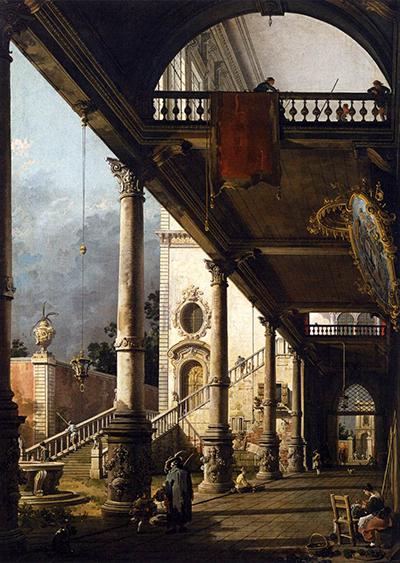The Perspective with a Portico was a masterpiece during its time. Painted during the Rococo era, the picture opened up a different angle to the oil and canvas paintings in the 18th century. Canaletto (born Giovanni Antonio Canal) credits the painting's fame to the wise tutorial from his father who doubled up as his mentor and teacher.
Most of his painting have a topographical bias, thanks to the environment he grew in. He was inspired by nature, architecture and Venice - his homeland. The painting was done and completed between 1763 and 1765. Done on canvas using oil, it showed a glimpse of a staircase into the horizon in a bright afternoon. Canaletto was a master in the capriccio genre – an architectural-inspired form of painting. The painting is an opening to a veranda which is highly guarded. There are dogs chained to the pillars with an armed man walking by. It measured 51.5 inches high and 36.6 inches wide. In the middle ground, some stairs lead to the upper deck of the building. The background is dominated by high walls build with an aristocratic taste. This painting depicts nobility and all the trappings of wealth and power. The house architectural design and the sense of belonging gives the viewer the front seat into a Portico (the entrance into a mansion).
Canaletto was inspired by the Ca' d'Oro. It was done at the Gallery of the Academy in honour of the leadership position he was given at the institution. Other paintings done in the same year include the Scala dei Giganti (1765), Santa Maria Zobenigo and The School of San Marco. His biggest artistic influence was Giovanni Paolo Pannini whose drawing of the Venetian landscape was breath-taking. Most of his paintings were a representation of his hometown, especially the river. His Rococo signature style combined art, architecture and colours. His influence transcended into England in the mid-18th century. His pupils included Francesco Guardi, Gabriele Bella, Bernardo Bellotto, Giuseppe Bison and Giuseppe Moretti. The Perspective with a Portico was first given to Academia as a gift. It was exhibited at the Saint Mark’s Square and taken back to the Academy where it is housed till today.




